How many times do bluebirds lay eggs? Well, a bluebird usually lays 4 to 6 powder blue eggs at a time and up to two clutches per breeding season, which means that each female bluebird can produce up to 30 to 50 offspring over 3 to 5 years.
One may also wonder, how many times do bluebirds lay eggs per year?
Bluebirds usually have two nesting’s or in some conditions three. How many eggs per nesting, and what do they look like? One egg is laid each day until the entire clutch is complete and mostly there is 4-6 powder blue or, occasionally, white eggs.
This article covers some basic and necessary information about Bluebird’s nesting and egg-laying habits, so you are well informed about your favorite wild bird.
Where do Bluebirds nest?
Bluebirds are known to be cavity nesters, which means that they only build nests inside a cavity or anything that resembles a chamber.
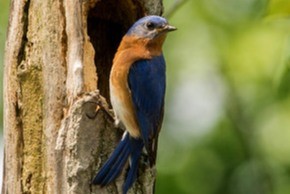
A cavity has an entrance that protects the nest, eggs, and brood.
Cavities can be natural, like those made by woodpeckers, or artificial, such as nesting boxes.
Cavity-nesting birds are categorized into two types.
Primary Cavity Nesters are those birds that are capable of making their cavity. A typical example is flickers and woodpeckers. Some birds can expand on the existing holes like Titmice and Chickadees.
Secondary Cavity Nesters are those that birds that are unable to make their cavities. They use cavities constructed by primary cavity nesters. Bluebirds fall in this category.
When using natural cavities, bluebirds prefer cavities excavated by woodpecker most of the time.
Bluebirds have no particular preference when it comes to artificial or natural cavities. Studies done on some bluebird pairs revealed that some birds nesting in a box and switched to a natural cavity, and vice versa, in a single nesting season.
Bluebirds nesting outside a cavity is a very rare instance and so far no evidence of a bluebird nesting outside a cavity has been recorded.
Nowadays a large number of Eastern Bluebirds nest in nesting boxes. There are a substantial amount of nesting sites available which is why there are no new records of bluebirds nesting outside cavities.
But Bluebirds are always in competition for nesting sites with other secondary cavity nesters such as Great Crested Flycatchers, Nuthatches, Swallows, European starlings, and House Sparrows.
When do Bluebirds build their nests?

Bluebirds are territorial birds and stay in their territories year-round, such as those residing in warm climates. Bluebirds of mid-eastern and southern warmer states initiate nesting earlier than those that migrate to the northern and cold regions.
Southern bluebirds begin nest building during February and March, the same period migratory Bluebirds are just arriving in the northern states.
Bluebirds in the states of Michigan and Minnesota start building nests in March and April.
Do Female Bluebirds build the nest alone?
Male Bluebirds usually bring nesting material to the nest to lure the female into the cavity. This is a necessary part of the establishment of the territory and mating.
However, the male contribution to actual nest building ends there.
Bluebirds mate for life but the responsibility of nest building falls solely on the female. The female alone builds the nest in approximately 5 to 6 days.
The nest is shaped like an open cup. The base is composed of longer and thicker twigs, while the cup is lined with delicate and more flexible twigs often mixed with pieces of feathers and hair.
When does bluebird egg laying begin?
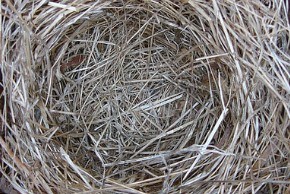
The female usually starts laying 6 to 7 days after building the nest. This is about 13 to 14 days after starting the nest.
Nest building time plays a critical role in the overall timing of egg-laying throughout the Bluebird’s range.
In warmer southern states egg-laying begins during February and March and March and April in the northern and colder states.
During April, most breeding pairs are incubating eggs.
How many eggs does a female Bluebird lay?
Typically a female bluebird lays 4 to 5 eggs, and in some cases up to 7 eggs. The female lays one egg per day.
On extremely rare occasions, two females use the same nest to lay their eggs. Both females incubate and feed the chicks.
When does egg incubation start?
Bluebirds start incubating the eggs on the very same day the female lays the last egg of the clutch. A female will rarely start incubating the eggs a day before the last egg is laid.
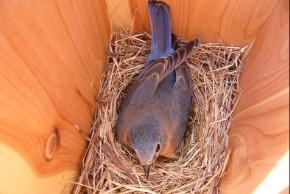
Incubation time is slightly shorter in warmer regions and longer in colder states.
The Bluebirds breeding season usually lasts 83 days on average or nearly three months.
The color of the Bluebird egg is powdered blue. But rarely some females lay white eggs or pink eggs.
Egg color is not variable within a clutch. A female will either lay all blue, white, or pink eggs.
What is the Incubation Period?
The incubation period of Bluebirds range varies with temperature. Generally, Bluebirds incubate their eggs for 13.5 days on average. In warmer states, the incubation period is shorter than in colder states.
Do male and female Bluebird both incubate the eggs?
Eggs are incubated only by the female Bluebirds. The male does not partake in the incubation of the eggs.
The male defends the nest and brings food to the female while she is incubating the eggs.
The females only take breaks to feed and poop throughout the day.
During these breaks, both the male and female feed near the nest and keep an eye out for predators approaching the nest.
When do Bluebirds abandon their nest and eggs?
If a mated bluebird pair abandons their nest and eggs, it is because either the male or female has died.
Male and female Bluebirds have very specific roles during the breeding season and the timing of losing one member of the pair may result in different results.
Circumstances include:
- If the female dies during the nest building, egg-laying, and incubation periods, the breeding effort fails because the male does not do any of these activities.
- If the male dies during egg-laying and incubation, then research shows that the female will likely abandon the nesting effort.
- If the female dies when the clutch is very young, the nesting effort fails because the male does not brood the fledgling, and they will die from hypothermia.
- If the male dies when the clutch is very young, the female could raise the fledgling.
- If either the male or the female dies when the chicks are still in the nest but have feathers to regulate their temperature, the remaining parent can raise the young through fledging.
While any of these circumstances can result in nest desertion, a likely result is that another bird replaces the missing member of the pair. The new replacement may help feed the young if these are old enough or about ready to fledge. But the new replacement might not show interest in eggs or very young nestlings.
When do female Bluebirds abandon the nest?
Occasionally the female bluebird stays away from the nest in extremely hot temperatures. The female bluebird stays outside and returns when she realizes that the eggs need to be incubated.
If the female has not returned to the nest for two consecutive days, she may have died.
Another female might replace the missing female. This replacement time may take weeks or only a few hours if females nearby are available.
The new female will continue the nesting attempt if it is early enough in the season to start one.
How long will the female Bluebird sit on unhatched eggs?
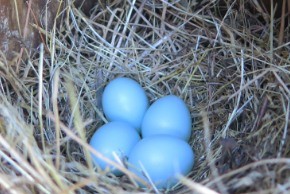
The female Bluebird will sit on her eggs until they hatch in roughly 13 to 14 days.
If some of the eggs do not hatch within three days after all other chicks have hatched, it means something went wrong.
If for some reason all eggs fail to hatch in 13 to 14 days, the female will continue incubating the eggs for a few more days until she recognizes that the clutch has failed.
The breeding pair then start building a new nest on top of the unsuccessful clutch and start a new breeding attempt.
When only one or two eggs do not hatch, the unhatched eggs are removed by the parents or are accidentally crushed by the growing chicks. The female then removes the shells.
If the reason eggs failed to hatch was the abandonment of the nest due to the death of either the male or the female, eggs should be presumed to be OK.
How to tell if an unhatched egg is still alive?
A live egg discharges CO2 and intakes oxygen through tiny microscopic pores on the shell’s surface. If this interchange of gases is happening, the egg would look smooth and shiny.
In the case of a dead egg, the surface looks dull. If the egg has been dead for some time, it should feel light.
If the egg has died recently, sniffing it should reveal a foul smell.
Dead eggs of other birds discharge a light brown substance. If the Bluebird egg secretes a substance of any color, they are dead.
Candling method
Candling method is used to detect if chicken eggs are still alive.
Gently take the egg to a dark room and hold the egg before a flashlight or candlelight. The light pierces the eggshell allowing one to see veins running through the egg or a red content signifying that the egg is still alive.
Should I remove unhatched eggs from a Bluebird nest?
You should never remove unhatched eggs unless you are sure the nest has been abandoned or the eggs have failed to hatch.
Why do some Bluebird eggs fail to hatch?
There are many possible reasons and often we don’t know why an egg fails to hatch.
Some of the more likely reasons include extremely hot or cold temperatures, pesticide exposure to pesticides, hereditary issues, and bacterial infections.
Cold weather is the main culprit in eggs failing to hatch.
Different bacteria might also find their way into the egg during egg formation inside the female. Bacteria continue to grow after the egg has been laid and ultimately kill the egg.
Why do female Bluebirds lay eggs in another pair’s nest?
Occasionally, Bluebird females lay fertile eggs in another pair’s nest.
This phenomenon is called conspecific brood parasitism, which occurs when a female uses another pair to raise their clutch.
This usually happens when a female with fertile eggs loses its nest when laying eggs. She must lay her egg somewhere rather than losing them.
Female Bluebirds usually guard their nests to prevent other females from laying eggs in their nests. Regardless of that, other females manage to sneak into other nests and deposit their eggs.
Bluebird eggs have also been found in nests of other cavity-nesters birds like Carolina Wrens, Chickadees, and even House Sparrows.
Do Different bird species lay eggs in a Bluebird nest?
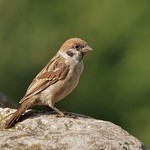
Although this is not common, other than a Bluebird some other bird species like European starlings, Brown-headed Cowbirds, and House Sparrows have been found to lay eggs in a bluebird nest.
The Brown-headed Cowbird is a known brood parasite. But this is a rare occurrence as Cowbirds are fairly big birds and if the cavity entrance to a Bluebird nest is small as to not allow a female cowbird easy access.
The same holds or nesting boxes and smaller diameter entrances make it hard to be parasitized by cowbirds.
How do Bluebirds react to the presence of eggs from other bird species?
Most female Bluebirds that detect eggs from other birds will cover the whole clutch with nesting material, build a new nest, and start another nesting attempt.
What are the main predators for Bluebird eggs?
- Main predators that can damage bluebird eggs include House Sparrows, House Wrens, and woodpeckers.
- Predators that can kill young birds include fire ants.
- Predators that can eat eggs, young birds, and adults include cats, raccoons, and snakes.
